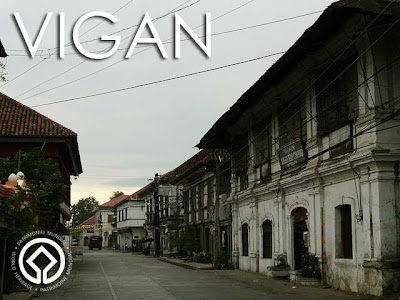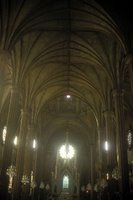
The Philippines is a country rich in cultural and natural heritage. But unfortunately, it has not had any site inscribed in the UNESCO World Heritage List since 1999. There are several factors behind this including (1) the lack of awareness about UNESCO World Heritage among local stakeholders, especially the indigenous communities, local governments and residents that live around these potential sites, (2) the absence of competent people who are fully aware of the processes involved in preparing and providing the correct documents for nomination as World Heritage; and (3) the lack of government funding to prepare and support these nominations, among many others.
It was thus timely that the theme for the UNITAR Series on the Management and Conservation of World Heritage Sites this year was Preparing World Heritage Nominations: Continuity and Change within UNESCO's New Manual. In previous workshops, the focus was on management and conservation. I sent in my applcation and was lucky to be among the 26 selected from over a hundred applications from around the world. Two other Filipinos were with me this year: Dr. Florentino Hornedo, the new lead consultant for the Batanes nomination, and Erwin Sebastian of the National Museum.
There was a heavy emphasis on Comparative Analysis which is the key element in nominations. And ironically, it's one which many take for granted. The UNITAR training was definitely an eye opener on the UNESCO nomination process. It's now evident why we haven't had any Philippine nomination succeed in over a decade!
One thing I learned is describing your property as "unique" is the worst argument one could give for UNESCO nomination. In reality, all sites are not unique and there are always similar properties it can be compared with. Outstanding Universal Value (OUV) based on at least one of the ten criteria has to be clearly established.
Comparative Analysis is one of the most vital parts of the UNESCO nomination. In fact, it may be the most important. This is where many nominations fail. Extensive comparison with other similar properties is vital to prove OUV and push nomination forward.
Most nominations also fail to draw conclusions. Why is it of OUV? Why is it the most representative of a particular category? Why should it go on the UNESCO World Heritage List? Nominations require deep analysis to succeed, not just a mere description of the site. You have to give clear answers to the whys.
That being said, Dr. Hornedo mentioned to me at the training that Batanes might have to wait until 2013. The whole nomination dossier has to be rewritten because the previous one did not hit the mark. After hearing some points from the previous nomination papers and after five days of training on the UNESCO nomination process, I tend to agree. Patience is a virtue. You have to make sure you get it right before submitting. Those writing the dossier simply don't know what the committee is looking for. Again, the key is on Comparative Analysis since it is this section which will prove OUV.
The problem is, even without the inscription, Batanes is already facing conservation issues which have to be addressed if it is to get inscribed. A management plan is vital for inscription in the list.
Over a year ago, I raised the alarm bells after visiting the village of Savidug in Sabtang. Several concrete houses were being constructed at the same time, damaging the architectural integrity of the village. In fact, the issue was raised in the PDI.
Several politicians retorted, "What right have you in Manila to tell us how to build our houses in Batanes?" They do have a point. But as Dr. Hornedo pointed out, it's the same politicians who modernize their houses who are also earning from tourism!
The reply to these arrogant politicians is, "What right have you to earn from tourist arrivals when you are the ones who destroy the very attraction people come to visit?" As Dr. Hornedo puts it, it's double persecution. It's the less-privileged Ivatans who do not have the money to modernize or build concrete houses. And yet their stone houses are the attraction. Isn't it ironic that they do not earn at all from tourism!
And here are the politicians, who build houses made of hollow blocks, they are the ones who make money from tourism. And yet they destroy their own stone houses. Now who would fly all the way to Batanes and take the falowa all the way to Sabtang just to see hollow block houses?
People who earn from tourism in Batanes, especially these local politicians, are the ones who benefit most from visitors who travel to Sabtang to see the stone houses. And here they are arguing for the right to build modern houses! These politicians better wake up and preserve those traditional Ivatan villages before it's too late.
There's nothing bad about building new houses. But there should be strict style guidelines on how they should be built. And French windows definitely don't fit in! During my recent visit to the village of Shirakawa-go, a UNESCO World Heritage Site, you could see how modern houses blend well with the traditional. Batanes should start implementing strict style rules for new constructions.
Anyway, we plan to organize similar workshops in the Philippines for local communities with sites in the Tentative List. I look forward to assisting localities in getting inscribed to the UNESCO World Heritage List. It's about time we get things right and get things done!
How to nominate a property to the UNESCO World Heritage List
Nominating cultural and natural sites to the UNESCO World Heritage List is no easy task. It takes many years, at times over a decade, to get a property inscribed. There are times that after all the hard work, the property gets rejected. Which is why it is important to understand the nomination process and what the World Heritage Committee and evaluators from ICOMOS and IUCN are looking for. If you are from a community with a property on the Tentative List, here are some documents to help you understand the process. If you are really serious, you will have to go through these documents of over a hundred pages each. It's a lot of reading, but definitely necessary.
Operational Guidelines for the Implementation of the World Heritage Convention
Preparing World Heritage Nominations Resource Manual
The World Heritage List: Filling the gaps
The World Heritage List: Filling the gaps (Annexes)





































